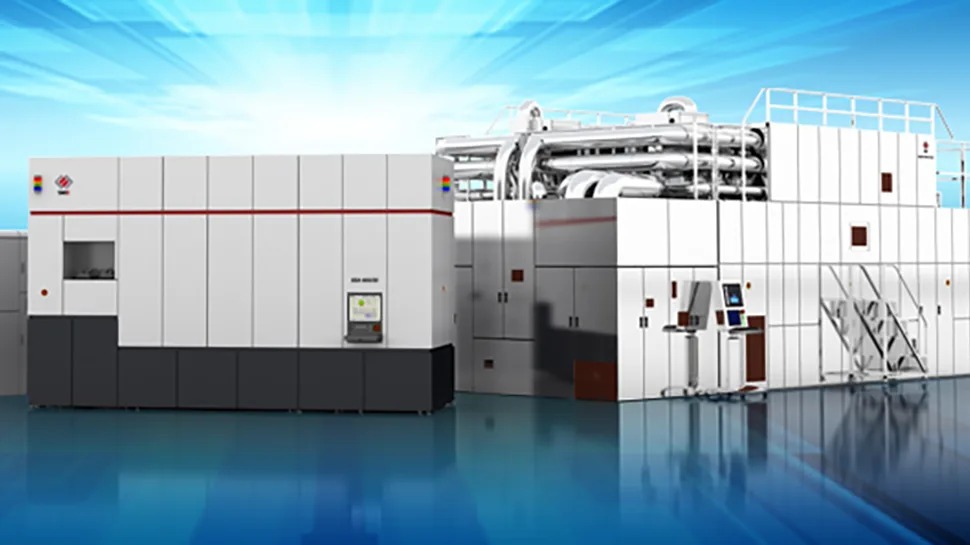China's First 28nm Lithography Tool to Be Delivered This Year

Image: Collected
Shanghai Micro Electronics Equipment (SMEE), China's most successful lithography scanner manufacturer, reiterated plans this week to deliver its first scanner capable of producing chips on a 28nm-class fabrication process by the end of the year, reports TechWire Asia, citing newspaper Securities Daily, which in turn cites an unnamed source.
For SMEE, its SSA/800-10W scanner is a breakthrough since the most advanced scanner that the company has today is only capable of 90nm and thicker fabrication processes. A 28nm-capable lithography tool will over time enable Chinese chipmakers to rely on domestic lithography equipment for a range of mature technologies.
The move is part of China's broader goal to achieve semiconductor self-sufficiency and reduce its dependence on foreign technology. But the question remains as to whether SMEE can produce this scanner in mass quantities, and when it can make such scanners available to substitute for machines from ASML, Canon, and Nikon.
The latest export regulations from the U.S. government prevent Chinese chipmakers from accessing tools and technologies essential for creating non-planar transistor logic chips under 14nm/16nm dimensions, 3D NAND chips with over 127 active layers, and DRAM ICs with a half-pitch smaller than 18nm. Restrictions from the Netherlands, Japan, and Taiwan that went into effect earlier this fall further isolated Chinese firms like SMIC and YMTC from advanced tools. These limitations impede their ability to produce chips using their newest manufacturing processes, notably SMIC's 14nm/12nm and 2nd generation 7nm as well as YMTC's 128-layer and 232-layer 3D NAND.
As a result, China needs advanced domestic lithography tools to ensure that its chipmakers can produce chips on even fairly advanced process technologies, such as 14nm. For now, it looks like Shanghai Micro Electronics Equipment is on track to reveal its 28nm-capable SSA/800-10W scanner, which it will ship either to SMIC or a chip research intitute.
After it does this, it will still take some time for the chipmaker to integrate the new scanner into its production flow. However, it will only do this only if SMEE can produce a sufficient number of such tools.
For SMEE, its SSA/800-10W scanner is a breakthrough since the most advanced scanner that the company has today is only capable of 90nm and thicker fabrication processes. A 28nm-capable lithography tool will over time enable Chinese chipmakers to rely on domestic lithography equipment for a range of mature technologies.
The move is part of China's broader goal to achieve semiconductor self-sufficiency and reduce its dependence on foreign technology. But the question remains as to whether SMEE can produce this scanner in mass quantities, and when it can make such scanners available to substitute for machines from ASML, Canon, and Nikon.
The latest export regulations from the U.S. government prevent Chinese chipmakers from accessing tools and technologies essential for creating non-planar transistor logic chips under 14nm/16nm dimensions, 3D NAND chips with over 127 active layers, and DRAM ICs with a half-pitch smaller than 18nm. Restrictions from the Netherlands, Japan, and Taiwan that went into effect earlier this fall further isolated Chinese firms like SMIC and YMTC from advanced tools. These limitations impede their ability to produce chips using their newest manufacturing processes, notably SMIC's 14nm/12nm and 2nd generation 7nm as well as YMTC's 128-layer and 232-layer 3D NAND.
As a result, China needs advanced domestic lithography tools to ensure that its chipmakers can produce chips on even fairly advanced process technologies, such as 14nm. For now, it looks like Shanghai Micro Electronics Equipment is on track to reveal its 28nm-capable SSA/800-10W scanner, which it will ship either to SMIC or a chip research intitute.
After it does this, it will still take some time for the chipmaker to integrate the new scanner into its production flow. However, it will only do this only if SMEE can produce a sufficient number of such tools.
Source: https://www.yahoo.com
Tags :
Previous Story
- China's Huawei sets up commodities hedging team in...
- Malaysia PM says China gave reassurance after map...
- China exported no germanium, gallium in Aug due...
- China Airlines rewards Dynasty Flyer members with monthly...
- German autos production under growing threat from China...
- J.P.Morgan, ANZ raise 2023 China GDP forecast
- Modi Enjoys a $3.8 Trillion Market Moment as...
- Apple Falls on Report That China Agencies Are...